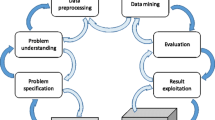Abstract
An online clustering method based on a time-varying quadratic programming is proposed which can precisely detect streaming data clustering structure when no assumption is desired on the shape and density of data classes. In the proposed method, online clustering is achieved through simulating some dynamical equations which yield optimum solution of the time-varying quadratic programming over time. A new framework is also proposed which efficiently permits streaming data clustering based on a relatively small and renewable dataset. This framework reduces the need for incoming data storage memory to a small and independent of original data size. The performance of the proposed method is evaluated through the experiments using synthetic data as well as the KDD cup 99 dataset. The results illustrate higher performance of the proposed method in comparison with a range of benchmark methods.





Similar content being viewed by others
References
Adibi MA, Shahrabi J (2015) Online anomaly detection based on support vector clustering. Int J Comput Intell Syst 8(4):735–746
Aggarwal CC, Han J, Wang J, Yu PS (2003) A framework for clustering evolving data streams. In: Proceedings of the 29th international conference on very large data bases, vol 29, pp 81–92
Aggarwal CC, Han J, Wang J, Yu PS (2004) A framework for projected clustering of high dimensional data streams. In: Proceedings of the thirtieth international conference on very large data bases, vol 30, pp 852–863
Ben-Hur A, Horn D, Siegelmann HT, Vapnik V (2002) Support vector clustering. J Mach Learn Res 2:125–137
Beringer J, Hüllermeier E (2006) Online clustering of parallel data streams. Data Knowl Eng 58(2):180–204
Boubacar HA, Lecoeuche S, Maouche S (2008) SAKM: self-adaptive kernel machine A kernel-based algorithm for online clustering. Neural Netw 21(9):1287–1301
Boukharouba K, Lecoeuche S (2008) Online clustering of non-stationary data using incremental and decremental SVM. In: Artificial neural networks—ICANN, pp 336–345
Cao F, Ester M, Qian W, Zhou A (2006) Density-based clustering over an evolving data stream with noise. In: SDM, vol 6, pp 328–339
Deng D, Kasabov N (2003) On-line pattern analysis by evolving self-organizing maps. Neurocomputing 51:87–103
Gao J, Li J, Zhang Z, Tan PN (2005) An incremental data stream clustering algorithm based on dense units detection. In: Ho TB, Cheung D, Liu H (eds) Advances in knowledge discovery and data mining. PAKDD 2005. Lecture notes in computer science, vol 3518. Springer, Heidelberg
Guha S, Meyerson A, Mishra N, Motwani R, O’Callaghan L (2003) Clustering data streams: theory and practice. IEEE Trans Knowl Data Eng 15(3):515–528
Kasabov N (2001) Evolving fuzzy neural networks for supervised/unsupervised online knowledge-based learning. IEEE Trans Syst Man Cybern B Cybern 31(6):902–918
Kharratzadeh M, Renard B, Coates MJ (2015) Bayesian topic model approaches to online and time-dependent clustering. Digit Signal Process 47:25–35
Kranen P, Assent I, Baldauf C, Seidl T (2011) The ClusTree: indexing micro-clusters for anytime stream mining. Knowl Inf Syst 29(2):249–272
Labroche N (2014) Online fuzzy medoid based clustering algorithms. Neurocomputing 126:141–150
Langone R, Agudelo OM, De Moor B, Suykens JA (2014) Incremental kernel spectral clustering for online learning of non-stationary data. Neurocomputing 139:246–260
Li Y, Li D, Wang S, Zhai Y (2014) Incremental entropy-based clustering on categorical data streams with concept drift. Knowl Based Syst 59:33–47
Lühr S, Lazarescu M (2009) Incremental clustering of dynamic data streams using connectivity based representative points. Data Knowl Eng 68(1):1–27
Nazemi A (2014) A neural network model for solving convex quadratic programming problems with some applications. Eng Appl Artif Intell 32:54–62
Ping L, Chun-Guang Z, Xu Z (2010) Improved support vector clustering. Eng Appl Artif Intell 23(4):552–559
Sahu SK, Sarangi S, Jena SK (2014) A detail analysis on intrusion detection datasets. In: Advance computing conference (IACC), 2014 IEEE international, pp 1348–1353
Schölkopf B, Smola AJ (2002) Learning with kernels: support vector machines, regularization, optimization, and beyond. MIT Press, Cambridge
Tao Q, Cao J, Sun D (2001) A simple and high performance neural network for quadratic programming problems. Appl Math Comput 124(2):251–260
Tavallaee M, Bagheri E, Lu W, Ghorbani AA (2009) A detailed analysis of the KDD CUP 99 data set. In: Proceedings of the second IEEE symposium on computational intelligence for security and defense applications
Wang Y, Zhang X, Wang S, Lai KK (2008) Nonlinear clustering based support vector machine for large data sets. Optim Methods Softw 23(4):533–549
Zhang Y, Li Z (2009) Zhang neural network for online solution of time-varying convex quadratic program subject to time-varying linear-equality constraints. Phys Lett A 373(18):1639–1643
Zheng L, Huo H, Guo Y, Fang T (2016) Supervised adaptive incremental clustering for data stream of chunks. Neurocomputing. doi:10.1016/j.neucom.2016.09.054
Zhou A, Cao F, Yan Y, Sha C, He X (2007) Distributed data stream clustering: a fast EM-based approach. In: International conference on data engineering 2007, ICDE 2007, IEEE 23rd, pp 736–745
Author information
Authors and Affiliations
Corresponding author
Rights and permissions
About this article
Cite this article
Adibi, M.A., Shahrabi, J. A time-varying quadratic programming for online clustering of streaming data. Pattern Anal Applic 21, 967–976 (2018). https://doi.org/10.1007/s10044-017-0608-9
Received:
Accepted:
Published:
Issue Date:
DOI: https://doi.org/10.1007/s10044-017-0608-9




